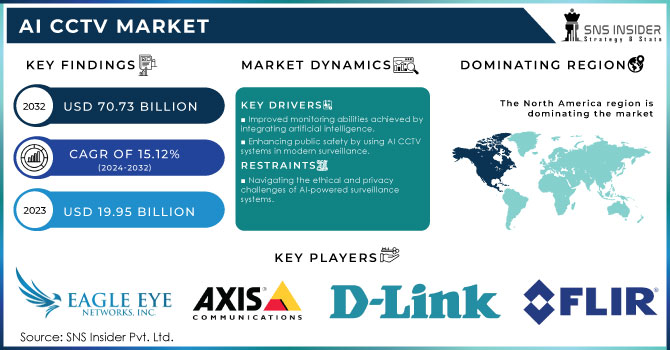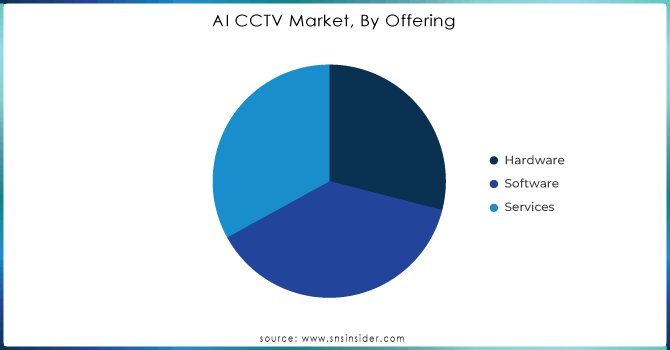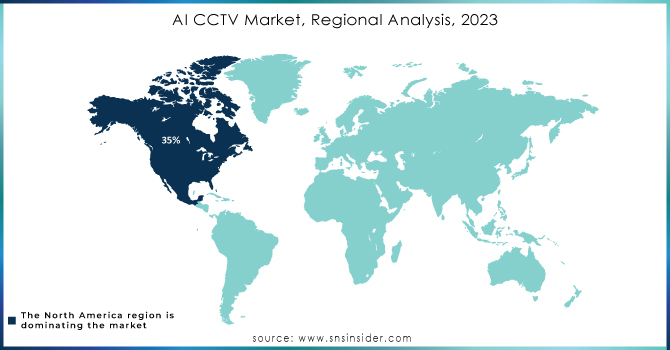AI CCTV Market Size:

To get more information on AI CCTV Market - Request Sample Report
The AI CCTV Market size was valued at USD 19.95 Billion in 2023. It is estimated to reach USD 70.73 Billion by 2032, growing at a CAGR of 15.12% during 2024-2032.
The rapid expansion of the AI CCTV market is driven by the growing need for advanced surveillance solutions in different sectors. Conventional CCTV cameras have been historically utilized for security reasons however, the incorporation of artificial intelligence (AI) has changed their capabilities, resulting in enhanced intelligence, effectiveness, and adaptability to advanced security requirements. Furthermore, AI surveillance systems are being more frequently utilized in different industries such as retail, healthcare, transportation, and government infrastructure. In the retail sector, AI-enabled surveillance cameras are utilized for monitoring customer behavior, studying foot traffic trends, and deterring theft. Around 70% of retail stores in the United States use CCTV systems for security purposes and to monitor customers. These systems have been proven to decrease theft incidents by 30%, making them an essential tool for preventing losses. Around 60% of shoppers believe they are safer in stores that have CCTV, showcasing the important role of consumer perception. The cost of installing these systems can vary from USD 1,000 to USD 5,000, based on the store's size and the complexity of the system. Moreover, about 45% of stores are embracing advanced technologies such as AI and facial recognition to improve security and collect customer data.
An important use of AI CCTV is in smart cities, where the technology is essential for ensuring public safety and managing traffic effectively. AI-powered CCTV systems can identify and monitor potentially suspicious behavior, assisting law enforcement in crime prevention efforts. In 2023, more than 60% of US cities have implemented CCTV surveillance for traffic lights, greatly improving traffic control. Research shows that this application resulted in a 20% decrease in accidents and enhanced traffic movement by around 15%, especially during busy times. For instance, Cubic Corporation and Siemens Mobility have created sophisticated solutions that combine CCTV with intelligent traffic management systems. By integrating AI, these functions help enhance urban safety by taking proactive security steps that decrease the chances of incidents occurring.
MARKET DYNAMICS:
Drivers
-
Improved monitoring abilities achieved by integrating artificial intelligence.
AI-enhanced security cameras greatly enhance surveillance abilities by incorporating features like facial recognition, object detection, and pattern recognition. Conventional CCTV systems only record video, while AI improves them with sophisticated analytic capabilities. Artificial intelligence surveillance cameras are capable of identifying abnormalities, monitoring questionable actions in the present moment, and forecasting possible security violations. AI cameras can detect abandoned items in busy areas, notify officials, and assess crowd actions to anticipate potential disturbances. This proactive method assists in avoiding crimes instead of responding after they happen, making AI CCTV a revolutionary tool in the security sector. AI surveillance systems also offer previously unattainable insights. For example, they can identify particular people using facial recognition technology, simplifying the process of spotting individuals of interest in public areas, airports, or important facilities. This is especially advantageous for police officers as it can be laborious to identify suspects in extensive datasets. AI significantly reduces the length of this process. Moreover, AI improves image clarity and is efficient in challenging lighting and weather conditions. Conventional systems struggle in such situations, whereas AI systems rely on machine learning algorithms to remove distractions and enhance images, enabling constant surveillance with precision 24/7.
-
Enhancing public safety by using AI CCTV systems in modern surveillance.
With the growth of urban populations, an increasing need for improved public safety is being observed. Metropolitan areas globally are experiencing increased levels of crime, risks of terrorism, and difficulties in ensuring compliance with laws. AI CCTV systems provide a remedy by offering improved real-time surveillance in crucial public locations such as airports, government facilities, public squares, and transportation hubs. Governments and cities are investing more in surveillance systems enhanced with AI to stop crimes, identify suspicious behavior, and enhance reaction times. This pattern is being driven by various well-known occurrences in which conventional surveillance systems did not succeed in identifying or stopping criminal behavior. In these situations, AI could have recognized suspicious actions or assisted in identifying people behaving abnormally. In addition, smart cities are projected to heavily depend on AI-driven surveillance for managing crowds, controlling traffic, and ensuring security. Implementing public safety measures frequently requires the use of widespread surveillance techniques, with AI CCTV systems being crucial in handling the large amounts of data involved. AI can analyze video quicker than human operators, leading to faster response times in emergencies and allowing law enforcement to be more preventative.
Restraints
-
Navigating the ethical and privacy challenges of AI-powered surveillance systems.
The extensive use of AI-powered surveillance cameras brings up major issues regarding privacy and ethics. Facial recognition, behavior analysis, and tracking AI systems raise concerns about widespread surveillance and potential abuse. Furthermore, incorporating AI into surveillance systems may result in bias in the algorithms utilized, possibly resulting in discrimination against certain ethnic groups or communities. If biased training data causes facial recognition technologies to make mistakes, innocent individuals may be unfairly accused or singled out. Governments all around the world are struggling with these moral dilemmas. Regulatory authorities in regions like the European Union have implemented strict data protection regulations, including the General Data Protection Regulation (GDPR), that may hinder the widespread implementation of AI CCTV systems. Businesses must make sure they follow these rules, which may increase implementation expenses and prolong project timelines.
KEY MARKET SEGMENTATION
By Camera Type
Dome cameras led the market in 2023 with a 36% market share because of their flexible design, broad field of vision, and strong security components. These cameras are commonly used for monitoring indoor and outdoor areas in commercial and public settings like shopping malls, airports, and offices because their stylish design camouflages well with the surroundings, reducing their visibility to potential trespassers. Dome cameras frequently utilize AI features such as facial recognition and motion detection to improve real-time surveillance abilities. Hikvision's dome cameras are extensively used in smart city initiatives, providing high-quality video and AI-driven analysis for monitoring traffic and managing crowds.
PTZ cameras are going to experience a rapid growth rate during the forecast period 2024-2032 because they can effectively monitor large areas and provide precise zoom and movement control. This makes them perfect for dynamic settings like stadiums, city surveillance, and expansive outdoor spaces. The ability to control these cameras from a distance is enhanced by AI functions such as object tracking and automated alerts, making them more adaptable in various scenarios. Axis Communications provides PTZ cameras designed for real-time monitoring and tracking of large crowds at sports arenas.
By Offering
The software segment held the most influencing market share i.e. 41% in 2023, leading the way in innovation and upgrades for surveillance systems. Sophisticated software solutions incorporate AI, ML, and analytics, allowing for immediate data processing and smart decision-making. These systems can detect irregularities, identify individuals by their faces, and anticipate possible security risks, offering organizations important knowledge. For example, Hikvision and Dahua Technology provide advanced AI technology that improves video analysis, making security systems more preemptive.
The hardware segment is accounted to have the fastest CAGR during 2024-2032 due to technological advancements and the rising use of high-definition cameras with AI features. With the focus on security increasing in organizations, the need for strong surveillance equipment like smart cameras and IoT devices is rising. The declining costs of AI hardware are aiding in the expansion of AI usage, allowing a wider variety of users to access the technology, including both small businesses and large enterprises.

To Get Customized Report as per your Business Requirement - Request For Customized Report
By Deployment
The cloud segment dominated in 2023 with a 56% market share. The rise is fueled by the growing need for security solutions that are scalable and flexible. Cloud-based systems make it simple to reach video feeds and store data without requiring a large amount of on-site hardware. For example, Amazon Web Services (AWS) offers cloud infrastructure for AI-powered CCTV solutions, allowing for real-time analysis and alerts, boosting situational awareness, and advancing response times.
The on-premise segment is expected to grow at the fastest rate during 2024-2032. On-site systems demand a significant amount of investment in tangible infrastructure, yet they offer improved security for sensitive data and adherence to strict regulations. Axis Communications provides strong on-site AI CCTV solutions that work with current security systems. These solutions offer advanced capabilities such as facial recognition and behavior analysis at the location itself, allowing easy access to important data without the need for external servers.
REGIONAL ANALYSIS:
North America captured a market share of over 35% in 2023 and led the market as it was an early adopter of advanced surveillance technologies, possesses a robust infrastructure, and has made significant investments in AI-driven security solutions. Substantial government efforts in the U.S. and Canada are driving the region's leadership in improving public safety. Artificial intelligence CCTV systems are commonly utilized to monitor traffic, detect crimes, and maintain workplace safety in various industries such as transportation, retail, and healthcare.
The APAC is accounted for experiencing a rapid growth rate during the forecast period 2024-2032 due to quick urbanization, higher government spending on smart city projects, and growing worries about public safety. China, Japan, and India lead in implementing AI surveillance, especially in managing cities and monitoring traffic. APAC is becoming a thriving hub for AI CCTV applications due to the increasing digital infrastructure, as well as a focus on improving traffic control and reducing crime.

KEY PLAYERS :
The key players in the AI CCTV market are:
-
Eagle Eye Networks (Eagle Eye Cloud VMS, Eagle Eye Camera Manager)
-
Axis Communications AB (Axis P32 Network Camera Series, Axis Camera Station)
-
D-Link Corporation (DCS-8526LH Full HD Pan & Tilt Pro Wi-Fi Camera, DCS-8302LH Full HD Outdoor Wi-Fi Camera)
-
Hangzhou Hikvision Digital Technology Co., Ltd. (DeepinMind NVR, Turbo HD Camera Series)
-
Panasonic Corporation (i-PRO X-Series Cameras, WV-SW458 Network Camera)
-
FLIR Systems, Inc. (FLIR FX Security Camera, FLIR Saros DH-390 Dome Camera)
-
VIVOTEK Inc. (IB9387-HT Bullet Network Camera, FD9167-HT Indoor Dome Camera)
-
Hanwha Techwin America (Wisenet P Series AI Cameras, Wisenet WAVE VMS)
-
Swann (Swann Enforcer 4K Ultra HD DVR, Swann Xtreem Wireless Security Camera)
-
Hikvision (DeepinView Series Cameras, AcuSense NVRs)
-
Dahua Technology (WizMind Cameras, AI-powered NVR)
-
Honeywell (MAXPRO NVR, Pro-Watch Video Management System)
-
Bosch Security Systems (Intelligent Video Analytics Cameras, DIVAR IP 6000)
-
Avigilon (a Motorola Solutions company) (H5A Camera Line, Avigilon Control Center)
-
Sony Corporation (6th Gen 4K AI Cameras, Edge Analytics Appliance)
-
CP Plus (AI-enabled Bullet Cameras, Intelligent VDP)
-
Cisco Meraki (MV22 Smart Camera, MV32 Fisheye Camera)
-
Tyco (Johnson Controls) (Illustra Pro Gen4 Cameras, exacqVision NVR)
-
Genetec (Omnicast Video Surveillance, Streamvault Appliances)
-
Pelco (Sarix Enhanced Cameras, VideoXpert VMS)
-
Mobotix (Mx6 Camera Line, MOBOTIX HUB VMS)
-
Uniview (UltraSmart Cameras, EZView VMS)
-
Fujitsu (AI-powered Surveillance Solutions, IP Surveillance Cameras)
Recent Development
-
September 17, 2024: Artificial Intelligence Technology Solutions, Inc. is pleased to announce the launch of RADCam, a cutting-edge residential security product developed by its subsidiary RAD-R or Robotic Assistance Devices Residential, Inc.
-
June 28, 2024: 3xLOGIC launched its four new AI-based cameras and imagers, including the VISIX Dual Thermal Imager and VISIX 5MP Ball Turret Camera. While the former provides in-depth learning analytics for the enhanced security of the retail, education, and commercial sectors, the latter can be used as a security camera in different fields.
-
April 2024: Axis Communications launched Q1656-LE, a box camera that enforces AI and uses a deep learning processing unit to ensure real-time object detection and improved analytics. Moreover, the camera is created for the most demanding outdoor security applications.
-
January 2023: Hikvision launched its 7 Series ColorVu Dual Light Cameras featuring AI analytics for better security performance in low-light conditions. The light that the cameras provide is sufficient even under complete darkness, while AI deployed in cameras is also regarded as one of the best solutions used for these video surveillance applications.
| Report Attributes | Details |
| Market Size in 2023 | USD 19.95 Billion |
| Market Size by 2032 | USD 70.73 Billion |
| CAGR | CAGR of 15.12% From 2024 to 2032 |
| Base Year | 2023 |
| Forecast Period | 2024-2032 |
| Historical Data | 2020-2022 |
| Report Scope & Coverage | Market Size, Segments Analysis, Competitive Landscape, Regional Analysis, DROC & SWOT Analysis, Forecast Outlook |
| Key Segments | • By Camera Type (PTZ Camera, Dome Camera, Bullet Camera, Box Camera, Others) • By Offering (Hardware, Software, Services) • By Deployment (Cloud, On-premises) • By End User (Residential, Commercial, Industrial) |
| Regional Analysis/Coverage | North America (US, Canada, Mexico), Europe (Eastern Europe [Poland, Romania, Hungary, Turkey, Rest of Eastern Europe] Western Europe] Germany, France, UK, Italy, Spain, Netherlands, Switzerland, Austria, Rest of Western Europe]), Asia Pacific (China, India, Japan, South Korea, Vietnam, Singapore, Australia, Rest of Asia Pacific), Middle East & Africa (Middle East [UAE, Egypt, Saudi Arabia, Qatar, Rest of Middle East], Africa [Nigeria, South Africa, Rest of Africa], Latin America (Brazil, Argentina, Colombia, Rest of Latin America) |
| Company Profiles | Eagle Eye Networks, Axis Communications AB, D-Link Corporation, Hangzhou Hikvision Digital Technology Co., Ltd., Panasonic Corporation, FLIR Systems, Inc., VIVOTEK Inc., Hanwha Techwin America, Swann, Hikvision, Dahua Technology, Honeywell, Bosch Security Systems, Avigilon (a Motorola Solutions company), Sony Corporation, CP Plus, Cisco Meraki, Tyco (Johnson Controls), Genetec, Pelco, Mobotix, Uniview, Fujitsu. |
| Key Drivers | • Improved monitoring abilities achieved by integrating artificial intelligence. • Enhancing public safety by using AI CCTV systems in modern surveillance. |
| RESTRAINTS | • Navigating the ethical and privacy challenges of AI-powered surveillance systems. |

